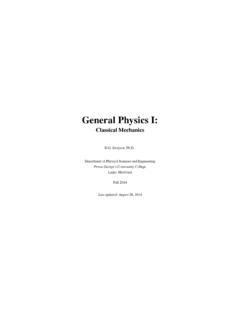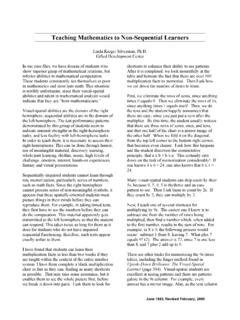Transcription of General Physics (PHY 2130)
1 General Physics ( phy 2130 ). Introduction Syllabus and teaching strategy Physics Introduction Mathematical review ~apetrov/PHY2130/. Chapter 1. Syllabus and teaching strategy Lecturer: , Room 358 Physics Building, Phone: 313-577-2739, or 313-577-2720 (for messages). e-mail: Web: ~apetrov/. Office Hours: MWF 10:40-11:35 AM, at 2009 SCI. MW 3:00-4:00 PM, on main campus, Physics Building, Room 358. or . Grading: 3 in-class exams (100 pts each) 300 pts Quizzes (5 out of 7 quizzes)/attendance 60 pts Final Exam 200 pts Online Homework (WebAssign) 40 pts BONUS: Planetarium visit 3 pts LABORATORY. PHY 2131 is the laboratory portion of phy 2130 . It is a co-requisite Laboratory is treated as a separate part of the course Your laboratory Manual will be available on Blackboard For further details: Dr.
2 Scott Payson at 313-577-3280. Lab sections of PHY 2131 begin in week of January 10. 3. QUIZ SECTIONS. Quiz sections meet once per week and are important. Allow you to meet together in small groups. Practice problems. Quiz instructors will work a few examples. You will be given 7 quizzes (5 best + attendance is reported to me). Five best quizzes plus attendance will be counted toward your final quiz score: Total possible = 60 pts [50 (quizzes) + 10 (attendance)]. No individual make-up quizzes will be given Math proficiency test: first quiz section! Make sure you attend. 4. EXAMS. There will be three regular, so-called hour exams (typically 50-55. minutes allowed) given during the term.
3 Each exam consists of Multiple Choice questions (no partial credit). Your lowest score of the three may be replaced by one-half of the final exam score, if doing so improves your grade. There will be NO make-up exams. If you miss an hour exam for any reason, that score of 0 will be your low score. You MUST bring your Wayne State ID to the exam and present it to a proctor when you hand in the exam. No electronic devices (other than a standalone calculator) are allowed in the room during the exam (no iPods, headphones, cell- phones, Blackberries, etc.). 5. ONLINE HOMEWORK. The WebAssign online testing system ( ). 40 points of the 600 point total for the course. If you purchase the textbook at the bookstore, it will include a WebAssign access card valid for two semesters.
4 ( Or purchase it through the internet). Details can be found in the Syllabus. Consult the WebAssign Student Guide for additional information. 6. TIPS FOR SURVIVING SUCCEEDING IN INTRODUCTORY. Physics . Purchase the text. Make use of the many helpful aspects of the text. Actually read the text (use a highlighter, if you prefer). Put in the time. At least 2. hours outside of the class for every hour of lecture. Practice, practice, practice. Strive for understanding. Come to the class. 7. ADDITIONAL STUDY HELP. Physics Resource Center, in room 172 Physics (the center will open a couple of weeks after the term begins). Your professor and quiz instructor 8. NOTE: If you need a certain letter grade in this class to get into/stay in a program, please keep track of your grade throughout the semester to make sure that you are WELL.
5 Above the required level. 9. Introduction 10. Why Study Physics ? Physics is the foundation of every science (astronomy, biology, chemistry). WSU: diverse set of problems, ranging from understanding the origins of the universe, to probing subatomic interactions, to studying the behavior of magnetic domains in hard drives, to characterizing single molecule diffusion. Many pieces of technology and/or medical equipment and procedures are developed with the help of physicists. Studying Physics will help you develop good thinking skills, problem solving skills, and give you the background needed to differentiate between science and pseudoscience. 11. Scientific Notation Is there a shorthand way of writing very large and/or very small numbers?
6 Prof. Sakamoto's lab: Studies of myosin (one of motor proteins). Size of the object: 10 nm = m Prof. Cackett's lab: Studies of X-ray binaries (star systems with one normal star and a black hole). Size of the object: 130 000 km = 130 000 000 m 12. Example: The radius of the sun is 700,000 km. Write as 105 km. When properly written this number will be between and Example: The radius of a hydrogen atom is m. This is more easily written as 10-11 m. 13. Physics Speak Be aware that physicists have their own precise definitions of some words that are different from their common English language definitions. Examples: speed and velocity are no longer synonyms;. mass and weight are no longer synonyms.
7 Acceleration is a change of speed or direction, etc. 14. Math Galileo Wrote: Philosophy is written in this grand book, the universe, which stands continually open to our gaze. But the book cannot be understood unless one first learns to comprehend the language and read the characters in which it is written. It is written in the language of mathematics, and its characters are triangles, circles, and other geometric figures without which it is humanly impossible to understand a single word of it; without these, one is wandering in a dark labyrinth. From Opere Il Saggiatore p. 171 by Galileo Galilei ( ~history/ ). Basically, the language spoken by physicists is mathematics. 15. This: y = mx + b x is multiplied by the factor m.
8 Means this: The terms mx and b are added together. 16. Example: x y = +c a x is multiplied by the factor 1/a or x is divided by the factor a. The terms x/a and c are added together. 17. Calculating percentages How would you calculate by how much a quantity changed if you are given by how many percent it increased/decreased? The General rule is to multiply the quantity by n . 1 . 100 . where the (+) is used if the quantity is increasing and ( ) is used if the quantity is decreasing by n percent. 18. Example: You put $10,000 in a CD for one year. The APY is How much interest does the bank pay you at the end of the year? $10,000 = $10,305. ! $. #1+ &. " 100% %. The bank pays you $305 in interest.
9 19. Example: You have $5,000 invested in stock XYZ. It loses of its value today. How much is your investment now worth? $5,000 = $4,680. 20. Proportions A B A is proportional to B. The value of A is directly dependent on the value of B. 1. A A is proportional to 1/B. The value of A is inversely dependent on the value of B. B. 21. Example: For items at the grocery store: cost weight The more you buy, the more you pay. This is just the relationship between cost and weight. To change from to = we need to know the proportionality constant. cost = (cost per pound) (weight). 22. Example A large ice cube is 30 in on each side. If the length of each side is increased by a factor of two, the surface area A) increases by a factor of.
10 B) increases by a factor of 2. C) increases by a factor of 4. D) increases by a factor of 8. A large ice cube is 30 in on each side. If the length of each side is increased by a factor of two, the surface area . Notations: let's call the length of the old side as aold and the new length as anew. Solution: Given: Recall that each cube has six faces. The area of each anew = 2 aold face is Aface = a2, so the total surface area is A = 6 a2. Thus, Find: 2. Anew 6a =. 2. new =. (. 6 2aold ) 2. 4aold = 2 =4. Anew/Aold=? 2 2. Aold 6a old 6aold aold Note: we did not use the fact that aold=30 in! Example A large ice cube is 30 in on each side. If the length of each side is increased by a factor of two, the surface area A) increases by a factor of.







